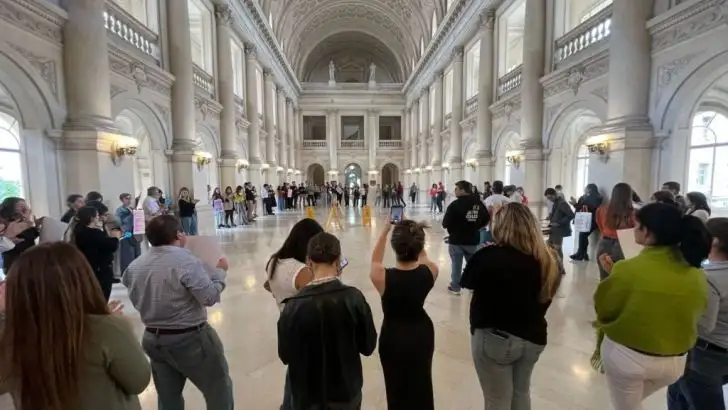Union conflict grows in court, there is recategorization, but it is insufficient

Far from subsiding, the union dispute reached its peak in the provincial courts over wage claims.
The curious thing is that last Wednesday, on the same day, the Superior Court of Justice (TSJ) approved promotions for more than 5,000 employees, and in the afternoon, it issued a memo warning of sanctions for future assemblies. This provoked a reaction and unity among the ruling party, the opposition, and the self-convened protesters , who came out en masse to anticipate direct action measures. A boomerang.
The Judicial Branch Employees' Union (AGEPJ) scheduled its meeting of the struggle table for last Friday. Members of the ruling party, chaired by Federico Corteletti , were present; two representatives of the opposition, led by Irina Santiesteban ; and three members of the self-convened movement that emerged and gained strength in the last two months. They resolved on a more aggressive plan of action than had been previously defined. It will begin with a 38-hour strike starting tomorrow, Monday, at 10:00 a.m. , and will extend through Tuesday. On Thursday, they will mobilize to Apross , and on Friday, the extraordinary assembly that had been called for the following week will meet. New actions, including legal ones, will be defined there.

Last Wednesday, ahead of May 1st, the general administrator of the Superior Court of Justice (TSJ) sent a memo to all staff reminding them of agreements made by that body dating back to 1997. He set the tone for union protests, with warnings about pay deductions for strike days —a measure he has already implemented— and a ban on noisy assemblies , mandating that they be held after 1 p.m. and on the street . "We're going back to the last century," stressed Adrián Valán, the union's union secretary.
The leader recalled that all of these agreements merited a recommendation from the International Labor Organization (ILO) to the Cordoba High Court.
That communication came at 3:00 PM, after most employees had closed their workday. It had a negative impact and also reignited the internal disputes within the Supreme Court between President Luis Angulo and member Sebastián López Peña .

That same morning, the Supreme Court of Justice (TSJ) had signed Agreement 502 Series A, which simplified the pay scale, reducing the 11 categories to six and reclassifying employees according to the new scales . A communication was also issued regarding this decision, explaining the percentage increases that each position will receive under the new system.
The news, far from being interpreted as a victory—it is indeed a step forward—was interpreted as a completely inadequate measure. The discontent intensified in the afternoon with official warnings about the continuation of the protest plan.
The reality is that the gap between judges and officials and the rest of the workforce in the Córdoba Judiciary is growing. Judges, prosecutors, legal advisors, secretaries, and deputy secretaries—the highest paid—were 90% equal to their federal counterparts. Employees were not .
Both groups receive the same increases granted by the Supreme Court of Justice. The most recent announcement was 2% retroactive to February 1, but it impacts the salaries of judges and civil servants unequally compared to staff. While all are "linked" to the increases ordered by the Court, they are not equal. And that is the crux of the conflict: the growing gap and inequity in a sector of highly professionalized workers , where the majority hold postgraduate degrees.
For example, the "official" position, a mid-level position, is approximately 75.5% lower than that of an employee with the same rank in the Federal Justice system, which does not even take entrance or promotion exams .
Furthermore, provincial judges receive a 27% discount on their salaries to contribute to Apross and the Pension Fund. And they are required to be exclusive. They are not licensed to practice privately.
If the government doesn't have more money, the Supreme Court has earmarked funds for expenses that could be considered superfluous, employees say. Social media has shown expenditures for catering totaling nearly $900,000.
"During the pandemic, they asked us to make an effort; now it's their turn," the bases point out.
What is restructuring ? Luis Angulo, president of the Supreme Court of Justice, led the negotiations with the provincial government. Governor Martín Llaryora is said to have been personally involved, along with his economics team, which analyzed the numbers.
The union had presented the bill in October 2023, during Domingo Sesín's presidency of the Superior Court, in a completely different economic context than the current one. Perhaps for this reason, what was once a success is no longer a success today.

It involves the elimination of categories, decreasing from 11 to six, and allows, in addition to automatic promotions , for a shorter judicial career. Official data provided by the Supreme Court indicates that this impacts 5,180 employees.
According to preliminary data, the largest salary increase will be seen by those in the lowest category, the meritorious workers who become "auxiliary workers," around 1,000 workers.
perfil.AR





